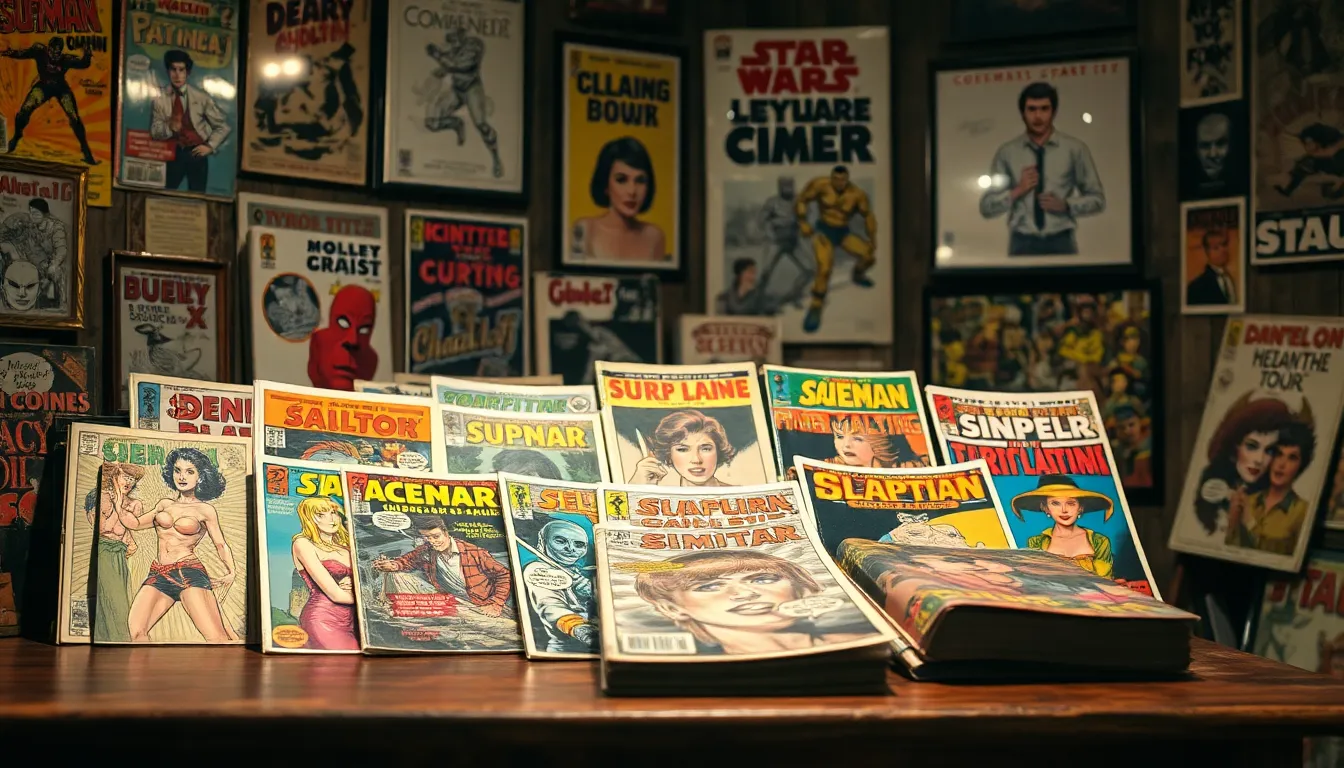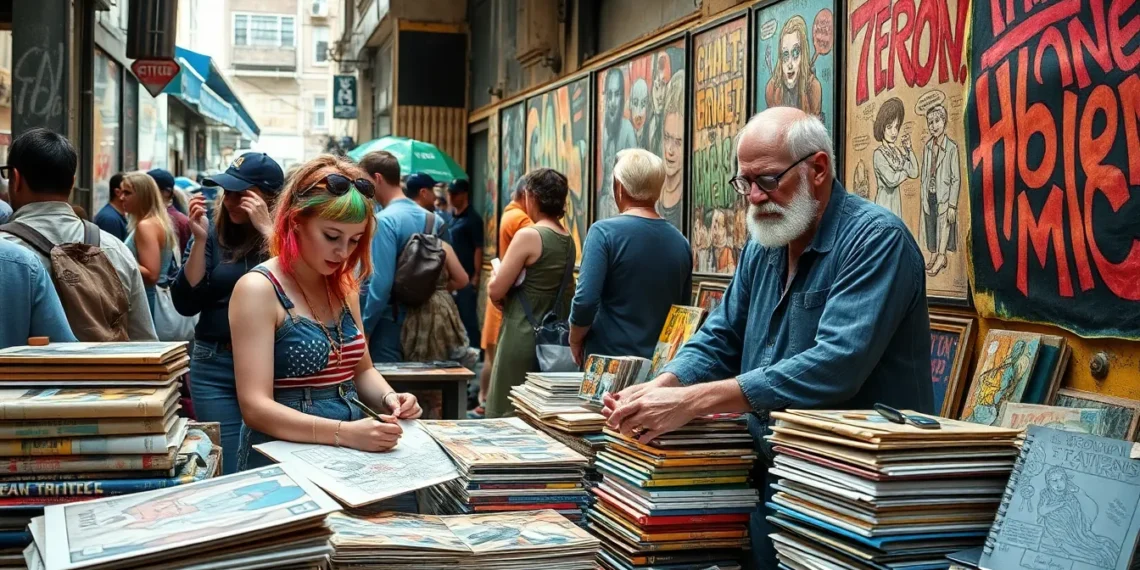In a world where mainstream comics often tread familiar paths, contemporary underground comics burst onto the scene like a colorful confetti cannon at a black-tie event. These vibrant works defy conventions, offering readers a refreshing mix of humor, social commentary, and artistic rebellion. They’re not just comics; they’re a wild ride through the minds of creators who refuse to play it safe.
Contemporary Underground Comics
Contemporary underground comics gained popularity in the late 20th century, reflecting diverse artistic voices. These comics often eschew conventional storytelling methods, instead opting for experimental formats and unique art styles. Cultural critique forms a core theme in many works, tackling issues such as identity, politics, and sexuality.
Genres within this sphere vary significantly, ranging from autobiographical narratives to surreal fantasy. Creators often prioritize personal expression and authenticity, leading to content that resonates on multiple levels. Readers encounter a raw, unfiltered glimpse into the artists’ thoughts and experiences.
Notable figures in this scene include Robert Crumb, who shaped the genre’s roots, and newer creators such as Kate Beaton and Julie Doucet, who push boundaries further. Their narratives challenge stereotypes and provoke thought, making each piece a reflection of contemporary society. Additionally, digital platforms have transformed distribution, allowing wider access and enabling rapid trends in storytelling.
Artistic styles within contemporary underground comics also differ markedly. Traditional comic aesthetics blend with punk and indie influences, creating visually striking works. Readers often observe a mix of detailed illustrations and minimalist designs, showcasing an array of creative approaches.
Accessibility plays a crucial role in the popularity of contemporary underground comics. Many independent publishers and zines focus on reaching niche audiences, providing literature that mainstream publishers often overlook. This democratization of the medium encourages new talent and fosters an inclusive environment.
Overall, the world of contemporary underground comics thrives on innovation and individuality, serving as a testament to the power of artistic expression.
Historical Context

Contemporary underground comics emerged in a unique cultural landscape. They developed from a broad array of influences, reflecting shifts in societal norms, art movements, and technological advancements.
The Evolution of Underground Comics
Underground comics began surfacing in the 1960s as an alternative to mainstream publications. The counterculture movement inspired many creators to express dissent through visual storytelling. Notably, the comic book medium evolved during the late 20th century, with artists exploring new themes and unconventional narratives. The 1980s and 1990s marked a significant shift, as independent publishers started to thrive, allowing diverse voices to flourish. New distribution channels also emerged, enhancing accessibility for creators and audiences. Alternative comics gained traction, pushing boundaries and redefining what comics could represent.
Influential Artists and Movements
Key figures played a vital role in shaping the underground comics landscape. Robert Crumb, known for his raw and unapologetic style, laid the groundwork for future generations. He confronted social issues and stereotypes, opening doors for other artists. The minicomic movement also gained momentum, showcasing self-published works by emerging creators. Artists like Julie Doucet and Kate Beaton contributed unique perspectives, often challenging norms. Their works reflected personal experiences and broader societal themes, resonating with diverse audiences. As these artists found their voices, the underground comics scene continued to evolve, fostering a rich tapestry of creativity and expression.
Key Themes in Contemporary Underground Comics
Contemporary underground comics frequently tackle pressing societal issues while offering bold artistic choices. Their unique voice allows for exploration beyond conventional narratives.
Social Commentary and Satire
Social commentary remains a significant theme in contemporary underground comics. Artists often use humor and satire to critique societal norms, politics, and cultural phenomena. For instance, creators examine topics like consumerism and environmental concerns, delivering insightful messages wrapped in engaging narratives. Robert Crumb’s satirical pieces reveal stark truths about American culture, while newer voices adapt these elements to address current events. Comedic yet poignant, their work encourages readers to reflect on real-world issues while enjoying the irreverent tone of underground comics.
Identity and Subculture Exploration
Identity and subculture exploration dominate contemporary underground comics. Creators delve into personal experiences regarding gender, sexuality, and ethnicity, presenting diverse perspectives often marginalized in mainstream media. Autobiographical narratives frequently illustrate these themes, pushing for authenticity and representation. Kate Beaton’s work, for instance, depicts the complexities of womanhood with humor and relatability. Readers encounter characters that resonate with their own experiences, providing a sense of connection within the larger subcultural landscape. These comics not only reflect individual journeys but also challenge prevailing stereotypes, promoting understanding and acceptance in society.
Notable Contemporary Underground Comics
Contemporary underground comics boast a variety of innovative voices and themes. These works provide insights into the art form’s depth through notable creators and influential titles.
Profiles of Prominent Artists
Robert Crumb defined the underground comic scene, known for his raw expression. Kate Beaton revolutionized storytelling through humor and historical depictions. Julie Doucet garnered acclaim for her autobiographical tales that explore identity and feminism. John Porcellino focuses on simplicity, capturing everyday moments with profound impact. Other artists like Marjane Satrapi, with her graphic memoirs, shed light on cultural experiences and societal issues. Each creator reshapes the landscape, challenging conventions and influencing new generations.
Must-Read Titles and Series
“Fritz the Cat” by Robert Crumb stands as a classic, blending humor with social commentary. “Hark! A Vagrant” showcases Kate Beaton’s sharp wit through reimagined historical narratives. Julie Doucet’s “Dirty Plotte” offers an intimate look at the artist’s life, intertwining personal and universal themes. “King-Cat Comic’s” by John Porcellino captures the beauty of the mundane through minimalistic art. “Persepolis” by Marjane Satrapi tells a compelling story of growing up in Iran, tackling identity and politics. These titles exemplify the power and range of contemporary underground comics.
The Impact of Technology on Distribution
Technology has transformed the distribution landscape for contemporary underground comics. Digital platforms have emerged, offering unprecedented access to a wider audience and enabling creators to share their work with ease.
Digital Platforms and Accessibility
Creators utilize various digital platforms to connect with readers globally. Webcomics, social media, and digital marketplaces serve as vital channels for distributing their work. These platforms allow independent artists to reach niche audiences that traditional publishing often overlooks. Readers can engage with comics directly, providing instant feedback and fostering a sense of community. Additionally, the low cost of publishing online removes financial barriers, promoting diversity within the genre.
Crowdfunding and Independent Publishing
Crowdfunding has revolutionized funding models for independent creators. Platforms like Kickstarter enable comic artists to finance their projects without relying solely on publishers. Successful campaigns provide creators the means to produce high-quality comics while maintaining creative control. Independent publishing flourishes as artists leverage this funding model to experiment with new ideas and formats. Engaging with backers helps build a loyal fanbase and supports alternative narratives that challenge mainstream perspectives.
Conclusion
Contemporary underground comics continue to push boundaries and redefine storytelling in the comic medium. They invite readers to explore diverse perspectives and challenge societal norms through humor and poignant narratives. This vibrant scene thrives on the creativity of its artists who embrace authenticity and personal expression.
As digital platforms evolve, these comics reach wider audiences, fostering a community that celebrates innovation. The impact of crowdfunding has empowered creators to pursue unique projects without compromising their vision. With each new work, contemporary underground comics affirm their significance in the broader cultural landscape, proving that artistic rebellion remains alive and well.







